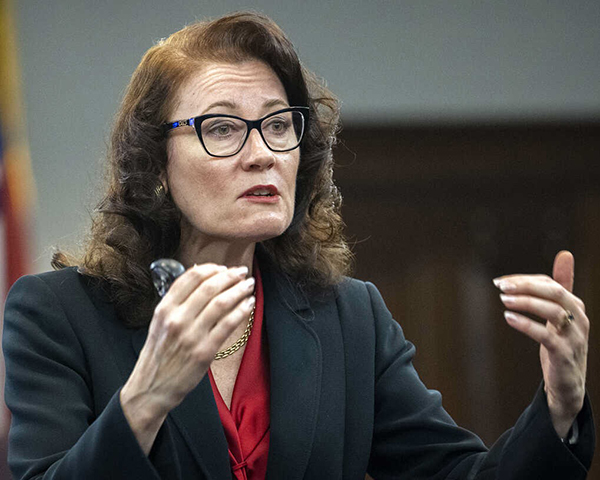By Earl Ofari Hutchinson
Contributing Columnist
“I saw the tape and it’s very, very disturbing,” he said. “I looked at a picture of that young man, he was in a tuxedo, and I will say that it looks like a really good young guy.”
That was former President Donald Trump talking to “Fox & Friends” moments after the tape was released of the slaying of Ahmaud Arbery in February 2020. This seeming pained reaction by Trump to the slaying punctuated the furious reaction to what appeared to be a blatant racially motivated killing of an unarmed African American by three white men, Gregory and Travis McMichael and William “Roddie” Bryan.
But Trump being Trump couldn’t let it go at that. He digressed from his unusual ramble at a subsequent press conference and dropped a big hint that there may be more than meets the eye in the murder of Arbery.
His exact words were there is an “empty spot “on the video of the deadly encounter. This was a not-so-subtle hint that Arbery may not be the innocent, blameless victim of his killers.
The ritual in racially motivated killings of African Americans by police or self-appointed vigilantes such as the three men charged goes like this. Dig up any prior arrest, bad behavior, or just plain dirt on the victim. Then plaster that everywhere and each time reference is made to the dastardly act, dredge up the victims’ prior suspect history.
The bad character reference to Arbery’s past had two aims. One was to deconstruct him as supposedly not the innocent choir boy the press depicted him as. The even more devious and insidious aim was to provide a plausible defense, even exoneration, of Arbery’s killers.
If enough doubt about Arbery’s character and motives could be publicly rehashed, then maybe the three men had probable cause to kill.
The pantheon of stereotypes and negative typecasting of young Black males is insidious. It’s the shortest of short steps to think that if Arbery can be depicted as a caricature of the terrifying image that much of the public still harbors about young Black males, then that image seems real, even more terrifying and the consequences are just as deadly.
The defense in the trial played hard on the alleged good intentions of the men chasing down Arbery while he was jogging. They suspected he was involved in a crime, and it was their self-imposed duty as former law enforcement officers to investigate.
The proof that they may have been within their legal right to do so was the alleged resistance of Arbery when confronted. This further heightened the cynicism of many Blacks that there will be no convictions.
Their cynicism over prosecuting police officers or even private citizens with past ties to law enforcement who overuse deadly force against unarmed Blacks is well warranted. The checklist of names — Tamir Rice, Ezell Ford, Eric Garner, Michael Brown and Trayvon Martin — is well-known. So, will the Arbery slaying be any different?
At first glance, it seems to have a better than even chance of beating the odds. Arbery was unarmed. He was shot while jogging. There was absolutely no evidence that he was committing a crime.
The principal video does show in graphic, and horrifying detail, the shooting. The men are also charged with a federal hate crime in the slaying.
These are all pluses that give some hope that the Arbery case will be different. But they don’t cancel out the still towering obstacles to conviction.
One is the words uttered by nearly every police officer in every slaying of an unarmed civilian, “I feared for my life or the life of others.” The three men uttered pretty much the same words. They claimed that Arbery posed a threat and that they acted in self-defense.
Those words are codified in law in many states. The operative words are “reasonably believes.”
Translated, that means that there is no written code, rule or guideline for what exactly reasonable belief is or means. It’s purely a judgment call the moment a person draws a weapon and opens fire.
The litany of “reasonable beliefs” can fill up a small phone book. The suspect was reaching for a knife, gun, toothpick, cell phone, tugging at his waistband, had his hands in his pocket or there was sudden movement of his vehicle.
In the case of Arbery, the defense is he was grappling with the men over a gun. And since they were in chase, they had reason to assume that Arbery might have been dangerous.
Despite overwhelming evidence that police profile minorities and lie, cheat, and even commit crimes, jurors still are far more likely to believe the testimony of police or former law enforcement officers and their defense witnesses than witnesses, defendants, or even the victims, especially minority victims.
Prosecutors have had many chances to bring charges against individuals who have killed unarmed suspects. They haven’t because as long as authority figures have the near impregnable shield of being able to say “I feared for my life” when confronting victims such as Arbery, it’s hard to convict them.
The Arbery slaying is the latest to test this daunting challenge.
Earl Ofari Hutchinson is an author and political analyst. His forthcoming book is “Duped — The GOP’s Lock on America’s Underclass” (Middle Passage Press). He also is the host of the weekly Earl Ofari Hutchinson Show on KPFK 90.7 FM and the Pacifica Network Saturdays at 9 a.m.












